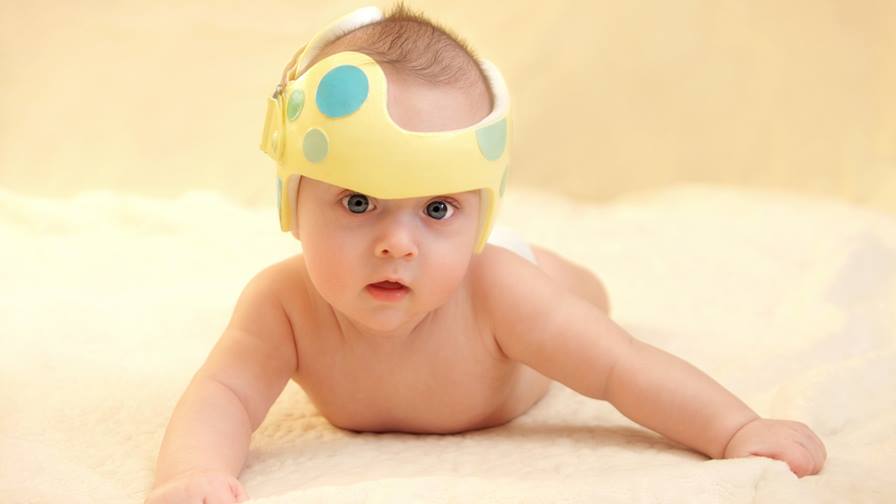Does my infant need a helmet? Understanding positional plagiocephaly
Parents naturally start to worry if a flat spot began forming on the back of your baby’s head. It can be scary not knowing if it will go away. Since 47% of infants have some sort of flat spot, and one in 10 needing treatment, you’re not alone. Your pediatrician may recommend a helmet for your baby to wear to help gently mold their skull back into a round shape.

Intermountain Healthcare
Jonathan Burnett MD, Intermountain Healthcare April 13, 2018
| What causes a flat spot on my baby’s head? |
Many parents who find out their baby needs a helmet start to blame themselves. You might even wonder if pesky flat spots — which are technically referred to as plagiocephaly — could have been avoided. The truth is, most babies don’t have perfectly shaped heads. In fact, most adults don’t have perfectly shaped heads either. Small flat spots and lumps are normal. When your baby has a large flat spot on their skull, it’s most often a result of birth — your baby’s skull may have become unevenly shaped while passing through the birth canal — or because they regularly lay flat on their back.
Your infant’s skull is malleable, which means the skull bones move more easily than they do in adulthood. This allows your baby’s head to move through the birth canal, and for their brain to grow during infancy. But it also means constant pressure to the back or side of the head can cause permanent malformation if it’s not corrected.
| When does my baby need a helmet? |
The shape of your baby’s head usually won’t cause brain damage or other developmental issues. In fact, most insurances and doctors consider a flat spot to be a cosmetic problem. So how do you know if you need to get a helmet for your baby?
Your doctor will check your baby’s head size and shape at each well-child visit. These visits happen about every 2 months during infancy. If your baby has a large flat spot that isn’t getting better by about 4 months of age, your doctor may prescribe a helmet. For a helmet to be effective, treatment should begin between 4 and 6 months of age. This will allow for the helmet to gently shape your baby’s skull as they grow. Treatment is generally considered ineffective after age 1 because the skull has started to fuse together
| What does wearing a helmet involve? |
Correcting positional plagiocephaly with a helmet isn’t for the faint of heart. You need to keep the helmet on your baby for 23 hours a day during treatment. Most of the time, helmets are worn for several months. Your child’s helmet will have to be adjusted regularly, sometime weekly, to keep up with their growth and changing head shape. Because insurance doesn’t always cover a helmet, it can be expensive to purchase and adjust a helmet regularly.
| Other treatment options for positional plagiocephaly |
Some research has shown that simple repositioning techniques may be just as effective as wearing a molded helmet. Your doctor may also suggest physical or occupational therapy to correct any additional problems like infant torticollis, which involves a twisted neck. These techniques can help you reposition your baby and give their skull the opportunity to correct flat spots on their own:
- Make tummy time a priority. Under supervision, place your baby on his tummy every day. This gives the back of your child’s head a break and helps your child strengthen his neck muscles.
- Cuddle. Holding your baby isn’t just great bonding time. It also relieves pressure on the back of your child’s head that happens naturally as your baby sits in a car seat, swing, or carrier.
- Change things up. Try placing your baby in positions that will force him to turn away from the flat spot on his head. Breastfeed from both sides. Put him down in his crib in different positions so he’ll have to turn to see you. You can also try moving his crib occasionally so no one spot on his head gets overused or flattened.
In most cases, your baby’s head shape will resolve on its own. Given time and a little effort, your baby’s head will grow and return to normal as they begin moving and doing more. Wearing a helmet is also a good way to correct large malformation or flat spots on your baby’s head. Ask your doctor if your baby needs a helmet and what you can do to correct his flat spot.
Source Intermountain Healthcare
| References |
Helmet therapy in infants with positional skull deformation: randomised controlled trial, van Wijk RM, van Vlimmeren LA, Groothuis-Oudshoorn CG, Van der Ploeg CP, Ijzerman MJ, Boere-Boonekamp MM. BMJ. 2014 May 1;348:g2741. doi: 10.1136/bmj.g2741. Full text
The incidence of positional plagiocephaly: a cohort study, Mawji A, Vollman AR, Hatfield J, McNeil DA, Sauvé R. Pediatrics. 2013 Aug;132(2):298-304. doi: 10.1542/peds.2012-3438. Epub 2013 Jul 8.
Reliable Assessors of Infant Cranial Asymmetry in Child Health Care, Lennartsson F, Wennergren G, Nordin P. Open Nurs J. 2015 Jul 31;9:33-41. doi: 10.2174/1874434601509010033. eCollection 2015. Full text
Nonsynostotic plagiocephaly: a child health care intervention in Skaraborg, Sweden, Lennartsson F, Nordin P. BMC Pediatr. 2019 Feb 6;19(1):48. doi: 10.1186/s12887-019-1405-y. Full text
Safe Sleep, Plagiocephaly, and Brachycephaly: Assessment, Risks, Treatment, and When to Refer, Marshall JM, Shahzad F. Pediatr Ann. 2020 Oct 1;49(10):e440-e447. doi: 10.3928/19382359-20200922-02.
Also see
Baby’s head shape: What’s normal? Mayo Clinic
Infant Torticollis Intermountain Healthcare
Why Your Baby Needs Tummy Time Intermountain Healthcare
More Babies Get Flattened Heads than Thought Medscape
